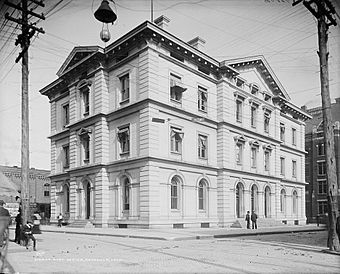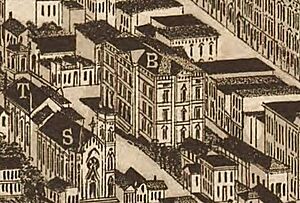Old Customs House (Knoxville, Tennessee) facts for kids
Quick facts for kids |
|
|
Old Post Office Building
|
|

The Old Customs House, as photographed by the Detroit Publishing Company in the early 1900s
|
|
| Location | Clinch Avenue and Market Street Knoxville, Tennessee |
|---|---|
| Architect | Alfred B. Mullett |
| Architectural style | Renaissance Revival |
| NRHP reference No. | 73001804 |
| Added to NRHP | March 20, 1973 |
The Old Customs House is a special historic building in Knoxville, Tennessee. It is also known as the Old Post Office. This important building is located at the corner of Clinch Avenue and Market Street.
It was finished in 1874 and was Knoxville's first federal building. For many years, it held federal courts, tax offices, and the post office. Later, from 1936 to 1976, the Tennessee Valley Authority (TVA) used it for their offices.
Today, after being expanded in 2004, the building is home to the East Tennessee History Center. This center includes the Lawson McGhee Library's Calvin M. McClung Historical Collection. It also has the Knox County Archives and the East Tennessee Historical Society's main offices and museum. The building is listed on the National Register of Historic Places because of its beautiful design.
Building Design and Style
The Old Customs House is a three-story building. It is built in the Italianate style, which was popular for its classic look. The building is covered in smooth, light-colored marble from East Tennessee.
The outside walls are smooth, but the corners have rougher stone blocks called quoins. These give the building a strong, old-fashioned feel. Inside, the former courtroom on the third floor has fancy, old-style decorations. Many parts of the inside have been changed over the years.
History of the Customs House
The land where the Customs House stands was once part of James White's plan for Knoxville. An old map from 1871 shows it as an open area with a few small houses nearby.
In the 1850s, cities across the country asked the U.S. Congress for federal buildings. They wanted places for courts and post offices. Congress was more likely to give money if the building was called a "Customs House." This name made it sound like the building would help collect taxes on imported goods. This way, the projects seemed to generate money for the government.
Congress first approved money for Knoxville's Customs House in 1856. They approved it again in 1869. The building was designed by Alfred B. Mullett, who was the chief architect for the U.S. government. Construction started in 1871 and finished in 1874.
The first floor was used as a post office. The second and third floors held the federal court. They also had offices for federal workers like postal inspectors and tax officers.
As Knoxville grew, the post office became very crowded. So, the Customs House was made bigger in 1910. A government paper from 1913 said the building was "clean and well kept." It also noted a "large and roomy" area for postal workers. The building had its own heating system and used electricity from a local company.
By 1934, Knoxville had grown even more. The Customs House was too small for the city's postal needs. A new post office was built on Main Street. The Customs House was then given to the Tennessee Valley Authority (TVA). The TVA used it for office space.
In the 1980s, the East Tennessee Historical Society (ETHS) moved into the Customs House. They set up the East Tennessee Historical Center. The Society first used the second floor, then moved to the first floor in 1992. The Museum of East Tennessee History opened there the next year. In 2000, a hallway on the second floor was named "Deaderick Hall." This honored a librarian named Lucile Deaderick.
In 2004, a new part was added to the east side of the Customs House. This new section was designed by BarberMcMurry. The whole complex is now called the East Tennessee History Center. It includes the ETHS headquarters, the Museum of East Tennessee History, the Calvin M. McClung Historical Collection, and the Knox County Archives. The Old Customs House is even shown in the ETHS logo.
Images for kids








